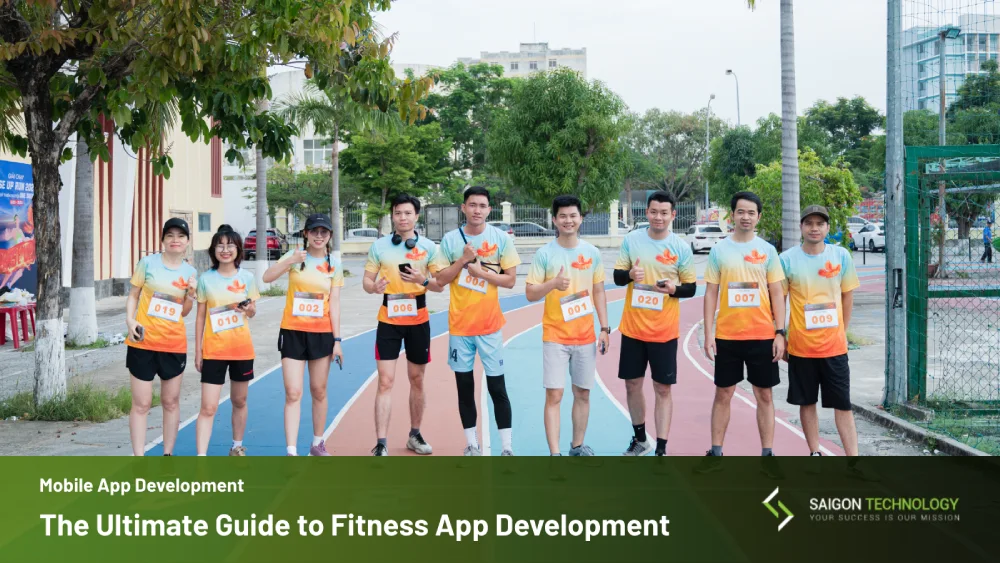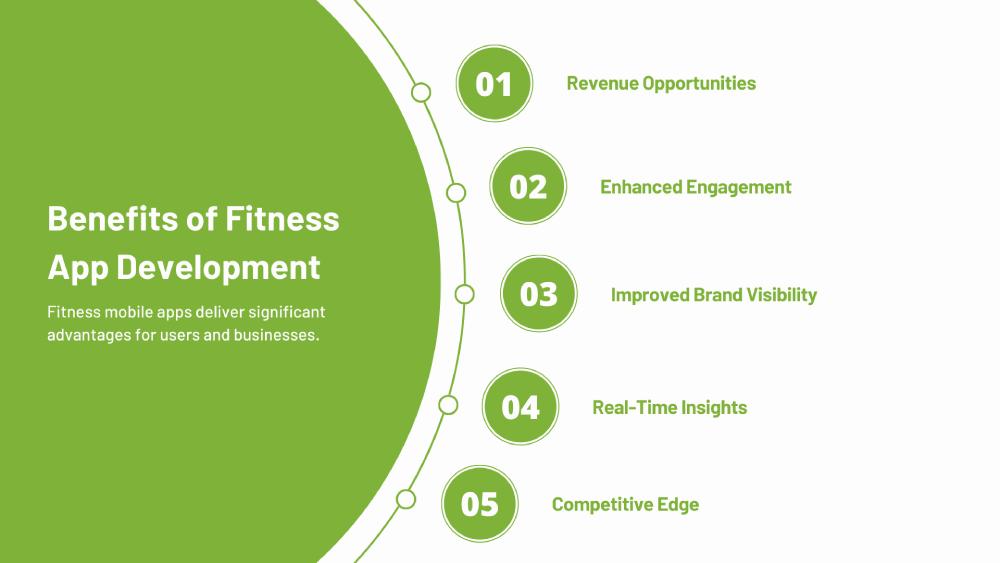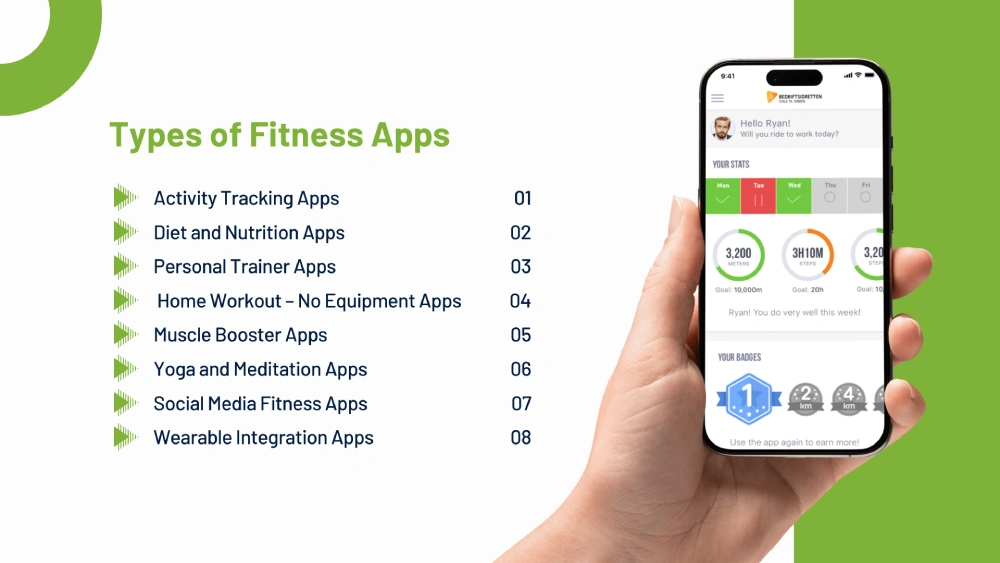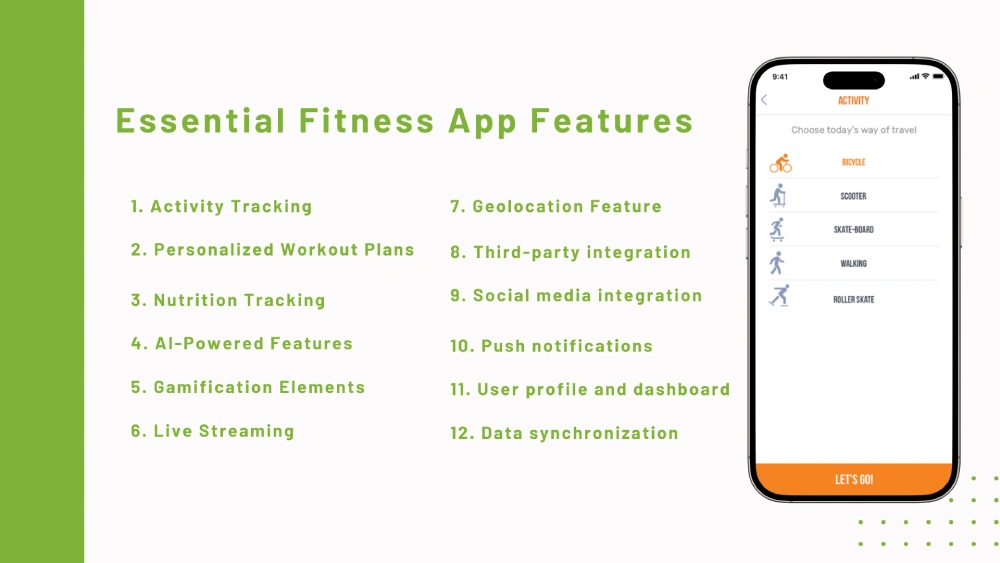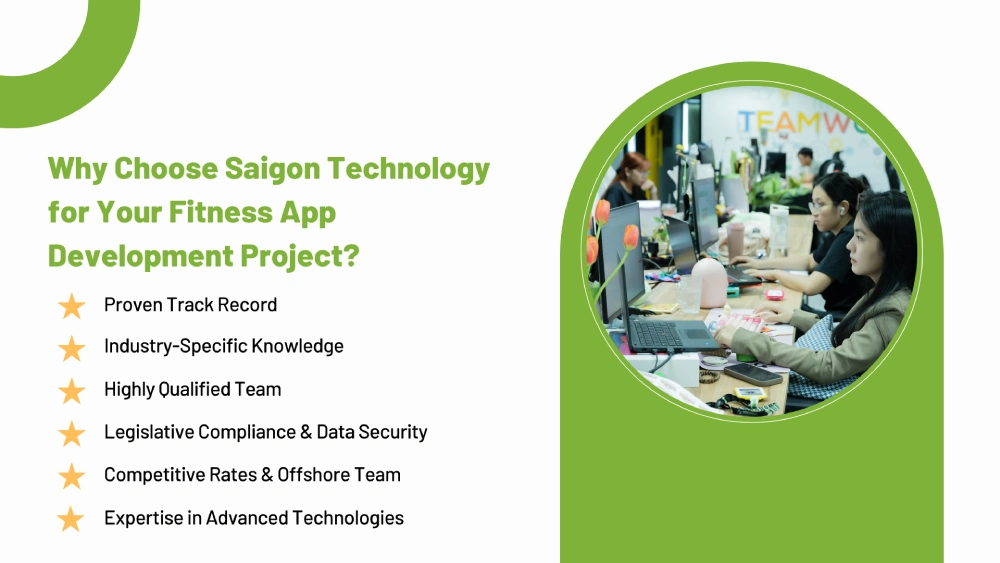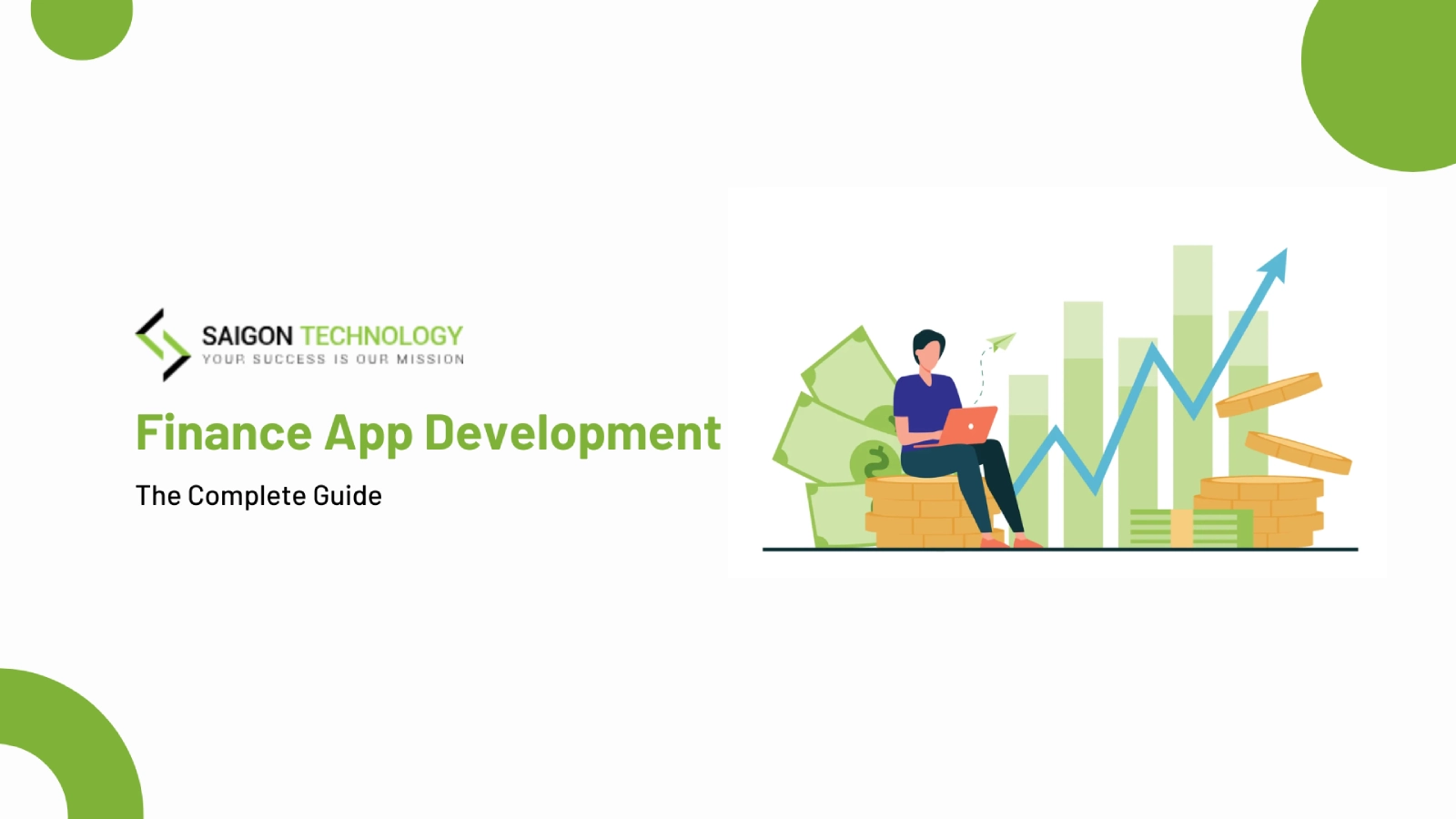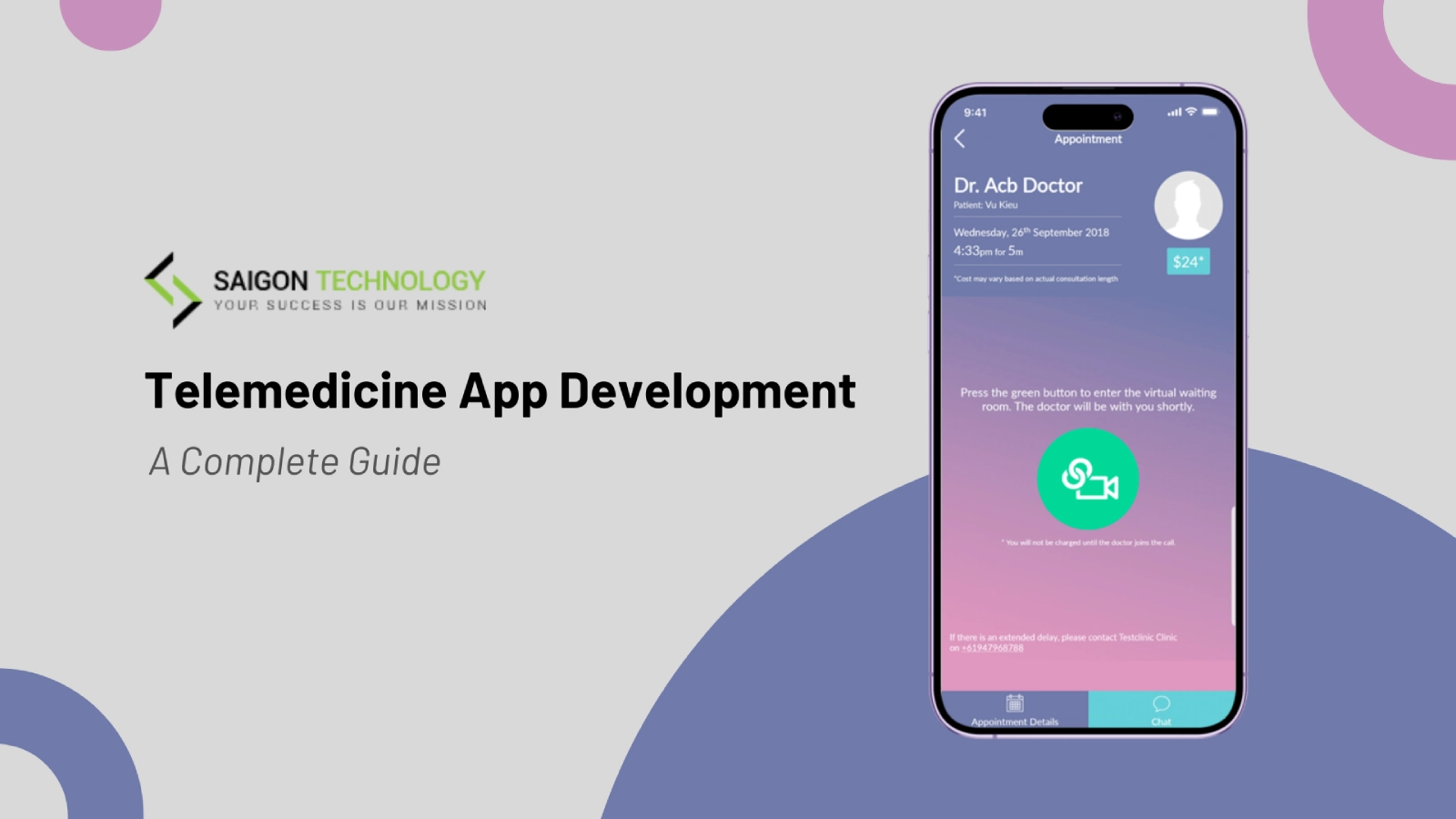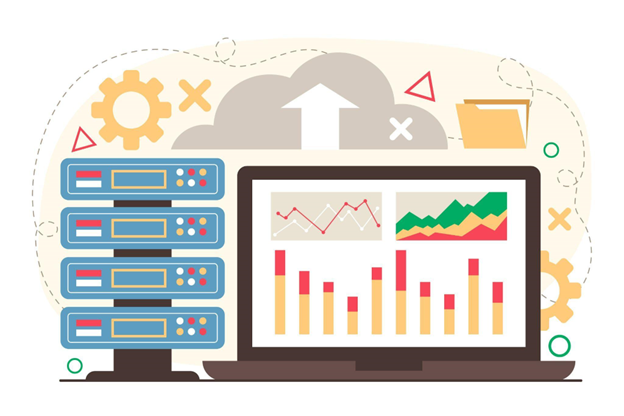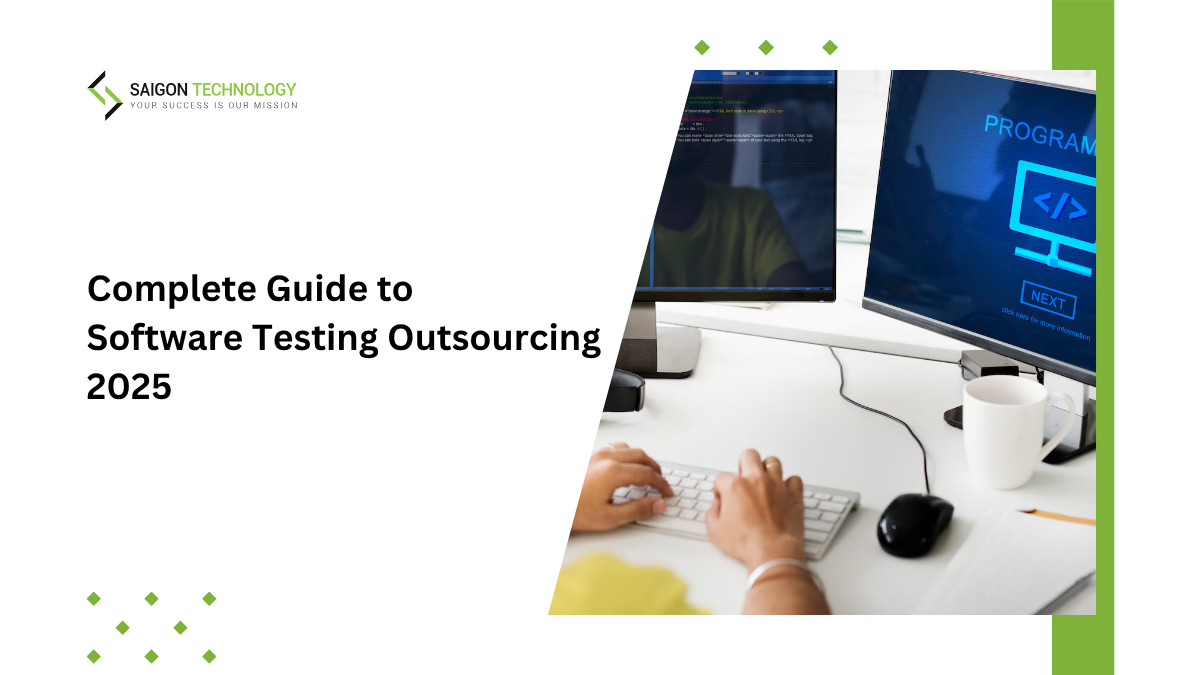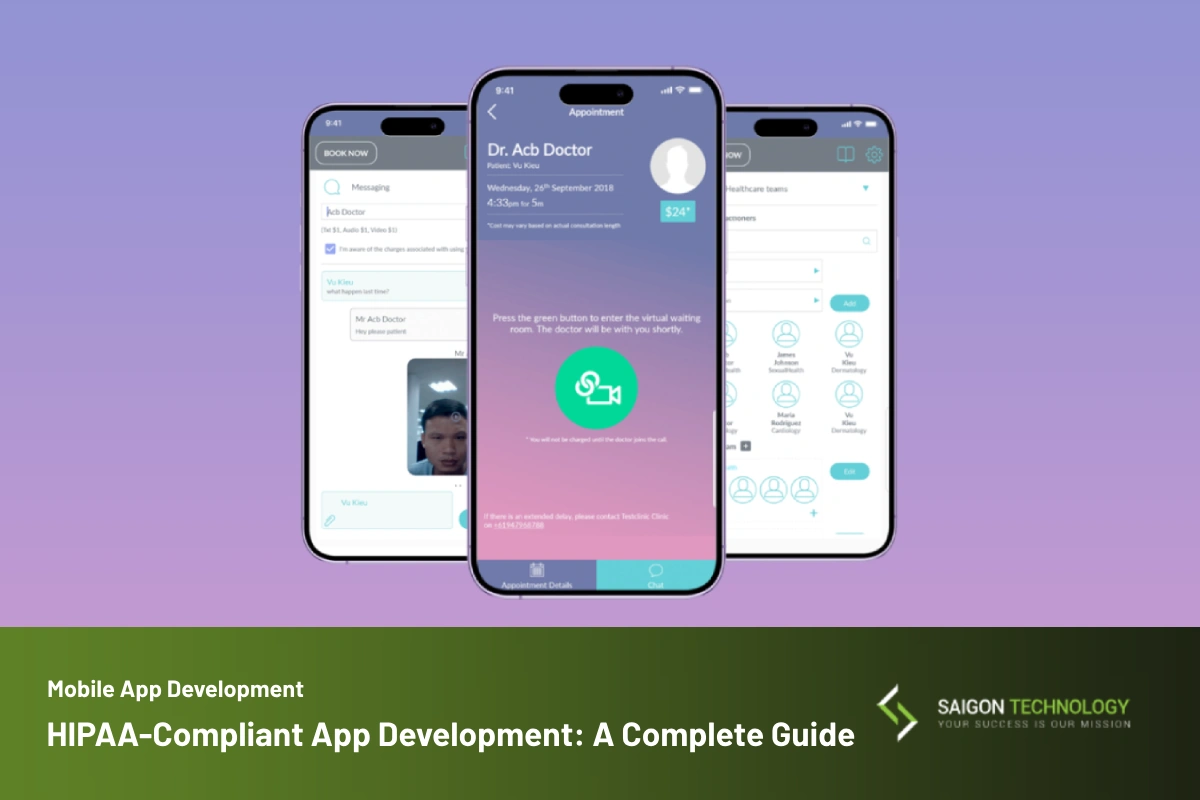The fitness app development market, a rapidly expanding segment of healthcare mobile app development, presents significant opportunities for entrepreneurs, startups, and development teams. Success in this field relies on understanding market dynamics, competitor strategies, and monetization approaches. The fitness app market was valued at $36.7 billion in 2023 and is projected to reach $134.5 billion by 2032, growing at a CAGR of 27.6%. This surge is driven by increasing health awareness, wearable technology adoption, and breakthroughs in AI.
Emerging trends in fitness mobile app development include AI integration for personalized workout planning, in-app gamification with challenges and rewards, and hybrid workout models combining virtual and physical training. Popular apps like MyFitnessPal, Strava, and Headspace showcase diverse functionalities, from calorie tracking and performance monitoring to mindfulness support, reflecting varied user demands.
Key features promoting the growth of fitness application development are AI-powered personalization, social connectivity through leaderboards, and seamless wearable integrations like Fitbit for real-time tracking. Monetization strategies include subscription plans offering a mix of free and premium content, freemium models with advanced paid features, and in-app purchases for exclusive content or tools.
Now is the ideal time to develop a fitness app tailored to the rising demand for health and fitness app development. By focusing on innovation and user-centric designs, developers can meet evolving market expectations and deliver impactful solutions. A well-planned approach can transform your vision into a powerful product in the competitive world of fitness mobile app development.
Ready to make your vision a reality? Leverage industry insights to create successful and empowering products and build your own fitness app. Contact us!
Fitness Software Development Overview
The fitness app market is thriving, driven by core fitness app features like activity tracking, personalization, and AI-powered tools. By 2025, revenue is expected to hit $8.30 billion, with an annual growth rate of 4.93% (CAGR 2025–2029), reaching $10.06 billion by 2029. User penetration will grow from 12.21% in 2025 to 13.21% by 2029, and the average revenue per user (ARPU) will reach $20.79. The U.S. remains a leader, with projected revenue of $2.49 billion by 2025. Key market trends, including AI-powered features and gamification elements, are shaping the future of the global fitness market.
Competitive Landscape
Major players differentiate themselves by leveraging core fitness app features:
- MyFitnessPal: Focuses on calorie tracking and nutrition databases.
- Strava: Combines activity tracking with social networking.
- Headspace: Prioritizes mindfulness and mental well-being.
- Bike to Work (Developed by Saigon Technology): This app empowers users to log their cycling activities, track routes, and monitor performance metrics. It serves as a prime example of how activity tracking apps can promote healthy habits, offering a user-friendly interface and seamless integration with GPS and fitness tools.
These apps showcase strengths in social media integration, wearable device integration, and user profile and dashboard features, driving user engagement. Effective competitor analysis highlights these distinctions, helping developers understand the evolving landscape of fitness software development.
Monetization Strategies
Revenue growth in fitness mobile app development is supported by:
- Subscription models: Tiered pricing for premium features like live streaming or customized plans.
- Freemium options: Basic free apps with paid upgrades.
- In-app purchases: Exclusive workouts, nutrition plans, or AI-powered coaching.
With increasing smartphone penetration, developers must integrate innovative features and flexible monetization strategies to stay competitive in the global fitness market.
Benefits of Fitness Mobile App Development
Fitness mobile apps deliver significant advantages for users and businesses.
Revenue Opportunities
- Subscription plans and in-app purchases create steady income streams in fitness mobile app development.
- Partnerships with fitness brands enhance advertising potential and expand reach, increasing the success of creating a fitness app.
Enhanced Engagement
- Gamification elements (e.g., badges, leaderboards) motivate users to stay active and engaged.
- Personalized workout plans, nutrition tracking, and AI-driven recommendations foster long-term loyalty through tailored user experiences.
Improved Brand Visibility
- Creating a fitness app boosts digital presence, making the fitness brand accessible to users 24/7.
- Social media integration builds a community, strengthens user trust, and highlights key app features like geolocation-based functionalities and live streaming.
Real-Time Insights
- Data synchronization helps refine app features and enhance the user experience.
- Analytics provide actionable insights for optimizing marketing campaigns and advancing fitness mobile app development strategies.
Competitive Edge
- Unique features like geolocation-based functionalities, live streaming, and AI-driven recommendations set your app apart, ensuring your place in the evolving landscape of fitness mobile app development.
Types of Fitness Apps
Fitness apps have exploded in popularity, offering a diverse range of tools to support various aspects of health and wellness. Here are some of the key categories:
1. Activity Tracking Apps: These apps monitor steps, distance covered, calories burned, and other key metrics. Many integrate with wearable devices like smartwatches and fitness trackers to enhance the user experience.
2. Diet and Nutrition Apps: These apps assist with meal planning, calorie tracking, and nutrition analysis. Features like barcode scanners and recipe databases can simplify food logging.
3. Personal Trainer Apps: These apps provide guided workouts with video demonstrations, personalized training plans, and progress tracking. Some even offer features like live coaching and community support. Workout guidance apps and personal trainer apps often overlap.
4. Home Workout – No Equipment Apps: These apps cater to users who prefer to exercise at home without the need for expensive equipment. They offer bodyweight exercises, yoga flows, and other routines that can be performed in any space.
5. Muscle Booster Apps: These apps focus on building muscle mass with targeted exercises, such as strength training and bodyweight workouts. They often include features like workout plans, progress tracking, and nutrition guidance.
6. Yoga and Meditation Apps: These apps offer a variety of tools for relaxation and mindfulness, including guided meditations, breathing exercises, and yoga poses. Some also incorporate features for stress management and mood tracking.
7. Social Media Fitness Apps: These apps combine fitness tracking with social features, allowing users to connect with friends, participate in challenges, and share their progress. This creates a sense of community and motivation.
8. Wearable Integration Apps: These apps seamlessly integrate with smartwatches, fitness trackers, and other wearable devices to provide real-time data and insights.
Additional Types of Fitness Apps
- FemTech Apps: These apps address the unique health needs of women, offering solutions for menstrual cycle tracking, fertility awareness, and other concerns.
- E-lifestyle Apps: These apps promote healthy habits beyond exercise and nutrition, such as sleep tracking, mindfulness practices, and stress management techniques.
Essential Fitness App Features
To succeed in the competitive fitness app market, a blend of core and advanced features is essential:
Core Features
- Activity Tracking: Real-time monitoring of steps, calories, and workouts with wearable device integration as a cornerstone of fitness app features.
- Personalized Workout Plans: Adaptive training programs tailored to individual goals, helping businesses make a workout app that caters to diverse needs.
- Nutrition Tracking: Barcode scanning and meal logging for macronutrient management, enhancing user experience in fitness mobile app development.
Advanced Features
- AI-Powered Features: Delivers personalized, real-time workout and diet suggestions, ensuring cutting-edge solutions.
- Gamification Elements: Incentivizes users with rewards, leaderboards, and challenges to boost engagement.
- Live Streaming: Enables group workouts or personal training sessions for a connected fitness experience.
- Geolocation Feature: Maps outdoor activities like running or cycling, adding a dynamic dimension to apps.
Integration Capabilities
- Sync with third-party integration platforms like MyFitnessPal or Google Fit to enhance functionality.
- Social media integration for progress sharing and community engagement, driving user retention.
User Engagement Tools
- Push notifications for reminders and motivation to keep users active.
- User profile and dashboard for tracking progress and trends, making data accessible and actionable.
- Data synchronization across devices for a seamless experience.
The growing fitness app market presents exciting opportunities for fitness mobile app development. By emphasizing essential fitness app features like activity tracking, gamification elements, and AI-powered features, businesses can create engaging, profitable solutions that meet diverse user needs while staying competitive in this dynamic space.
Fitness App Development Process
Building a fitness app requires a systematic approach to ensure quality and success. Here’s a concise guide to the fitness app development process:
Conducting Market Research and Product Discovery
Market Research: Study trends, user needs, and competitors’ strengths to identify market gaps for health and fitness app development.
Target Audience Definition: Understand the demographics, behaviors, and pain points of potential users.
Goal Setting: Define your app’s purpose and set measurable KPIs.
UX/UI Design
- Prototyping and User Experience Design: Sketch app screens to map out functionality and user flow.
- Customization of UX: Create a visually engaging and intuitive design for ease of use.
- Fitness Mobile App Design: Prioritize accessibility and user engagement for seamless navigation.
MVP Development
Define Core Features: Focus on essential functionalities like activity tracking and user profiles to create a minimum viable product (MVP).
Iterative Development: Launch an MVP to gather feedback and refine the app.
Fitness App Development
- Front-End Development: Build an engaging interface using cross-platform app development frameworks like Flutter or React Native
- Back-End Development: Develop a robust system for data processing and API integrations.
- Third-Party Integrations: Include payment systems, wearable device APIs, and social media features.
App Testing, Deployment, and Monitoring
- App Testing: Perform usability, security, and compatibility checks to ensure reliability.
- Deployment: Publish your app on the App Store and Google Play with optimized ASO strategies.
- Performance Monitoring: Track user engagement, app crashes, and overall performance using analytics tools.
Ongoing Support and Maintenance
- Support and Maintenance: Regularly release updates and new features based on user feedback.
- Compatibility and Scalability: Adapt to new platforms and growing user demands.
- Future Planning: Prepare for feature expansions to stay competitive in the market.
Ready to Build Your Fitness App?
Take the first step to make your own fitness app by partnering with experienced fitness app developers from Saigon Technology. Let’s turn your vision into a custom fitness app development solution that drives user engagement and market success! Discuss your app need!
Best Practices in Fitness App Development
Developing a fitness app that meets user expectations and industry standards requires thoughtful planning and execution. Here are expert recommendations for creating a successful and user-friendly app.
Prioritize UX and UI Design Principles
User Experience (UX):
- Streamline navigation with intuitive layouts and workflows.
- Minimize friction during onboarding, tracking, and goal-setting.
User Interface (UI):
- Design visually appealing interfaces that adapt to various devices.
- Use cohesive branding and engaging visuals to enhance user satisfaction.
Ensure Data Privacy Compliance
- Compliance Standards: Follow GDPR, HIPAA, and other regulations to safeguard user data.
- Security Measures: Implement encryption, secure APIs, and two-factor authentication.
Integrate Engaging and Motivational Features
- Diet Plans: Include tools for meal planning, calorie tracking, and nutrition guidance.
- Gamification Elements: Add challenges, leaderboards, and rewards to boost engagement.
- Motivational Features: Use personalized goal tracking and progress reminders.
Offer Personalized Recommendations with AI and Machine Learning
- Tailored Experiences: Leverage AI to provide customized workout and diet plans.
- Data-Driven Insights: Use machine learning to analyze user behavior for better engagement.
Emphasize Quality Assurance Testing and Real-Time Data Synchronization
- Quality Assurance Testing: Perform rigorous testing to ensure smooth app functionality.
- Real-Time Data Sync: Enable instant updates between devices and wearables.
Conduct Comprehensive Target Audience Analysis
Identify user preferences and segment your audience by fitness goals, age, or technical proficiency to refine features and maximize appeal.
Choose the Right Technology Stack
Adopt scalable frameworks like React Native or Flutter for cross-platform support. Use reliable back-end technologies to manage data efficiently.
Ensure Wearable Device Compatibility and User Profile Customization
- Wearable Integration: Enable seamless syncing with fitness trackers and smartwatches.
- User Profiles: Provide options for custom fitness goals and progress tracking.
Effective Monetization Strategies For Health And Fitness App Development
Building a financially successful Health and fitness app requires strategic planning and innovative revenue models. Here are key approaches to monetize your app effectively:
Subscription Models
- Implement tiered pricing plans with recurring payments for premium features.
- Provide free trials to drive user conversions.
- Examples: Offer monthly or annual memberships for advanced analytics or live workout classes.
Freemium Features
- Provide essential functionality for free while reserving advanced tools for premium users.
- Examples: Free users access basic tracking, while premium users enjoy AI-driven coaching or custom plans.
Paid Apps
- Charge a one-time fee for downloading the app.
- Ideal for niche apps with loyal audiences or unique features.
In-App Purchases
- Offer additional content or features as optional purchases within the app.
- Examples: Sell customized workout plans, fitness challenges, or virtual badges.
In-App Advertising
- Integrate ads such as banners, videos, or native promotions.
- Ensure ads are relevant and non-intrusive to maintain user satisfaction.
Sponsored Content
- Collaborate with brands to include branded workouts or nutrition plans.
- Examples: Work with supplement companies for sponsored fitness sessions.
Move-to-Earn Apps
- Reward users with incentives for completing fitness activities.
- Examples: Apps like Sweatcoin provide digital currency or discounts for physical activity.
Collaborations with Fitness Brands
- Partner with gyms, clothing brands, or equipment manufacturers.
- Examples: Promote gym memberships or sell branded products through the app.
Selling Physical Merchandise
- Use your app to sell fitness-related products.
- Examples: Offer branded yoga mats, water bottles, or fitness trackers.
User Data Monetization
Aggregate anonymized data to form partnerships with research institutions or wellness programs.
Ensure compliance with data privacy regulations like GDPR and CCPA.
Start Developing Your Fitness App Today!
Leverage these monetization strategies to build a profitable fitness app that engages users and meets their fitness goals. Take the first step toward custom fitness app development now! Contact us!
Cost of Developing a Fitness App
Fitness app development involves several cost factors, including UI/UX design, app complexity, feature selection, and geographic location of your development team. Whether you want to develop a simple application or a feature-rich platform, you should understand these elements to manage your budget effectively.
1. Cost Implications of UI/UX Design and App Complexity
The design of UI/UX is very important to retain users, but the cost of design varies. It can range from basic at $10,000 to $20,000 and advanced with custom graphics and animations above $50,000. App complexity also plays a significant role simple apps cost in the range of $30,000 to $50,000, while more advanced apps offering real-time tracking and integrations with third-party services fall within a range of $100,000 and $300,000.
2. Feature Selection
Key cost drivers include feature selection. The basic app will cost in the range of $30,000 to $50,000, while more advanced features like AI-driven suggestions, wearable integration, and virtual coaches will add to the cost. Platform compatibility is another factor-developing for both iOS and Android adds to the cost, but cross-platform frameworks like React Native or Flutter reduce the cost.
3. Costs of Rapid Prototyping and Regulatory Compliance
Prototyping is essential for fundraising and even testing with users. A simple prototype will cost from $5,000 to $15,000, while more advanced ones will be more expensive. Regulatory compliance like GDPR and HIPAA for fitness and health applications adds to the development cost, around $10,000 to $20,000, due to the development of specific features like data encryption and two-factor authentication.
4. Virtual Coaches: Costs and Integration of AI
The integration of AI-powered virtual coaches costs between $50,000 to $100,000 because it requires complex machine learning algorithms. Subscription models also add to the cost, with integrations like a payment gateway costing anywhere from $5,000 to $15,000, depending on the complexity.
5. Geographic Location of the Development Team
The location of your development team makes quite a difference in the cost. While developers from North America or Western Europe charge between $100 and $250 per hour, teams from Eastern Europe, India, or Southeast Asia quote between $30 and $100 per hour. Vietnam ($25-$50) falls within this range, offering a cost-effective option. While this is quite cost-effective, make sure that the developers have relevant experience in fitness app development.
6. Budget Management Tips
The way to manage your budget is to start with an MVP-a Minimum Viable Product that includes only the core features. This allows you to test your app, gather feedback, and scale with more features later, minimizing financial risks.
Plan Your Fitness App Development Cost Wisely
Knowing these factors will help you strategically plan your app’s feature list, tech stack, and location of the development team. Moreover, starting an MVP will help you keep the initial costs in check and scale up based on user feedback.
Contact us today to build your fitness app that aligns with your goals, user needs, and budget. Let’s bring your vision to life!
Essential Compliance Standards For Fitness Application Development
When developing a fitness application, ensuring adherence to key legal and regulatory standards is crucial for user trust and data security. Here are the top compliance standards developers must follow:
HIPAA (Health Insurance Portability and Accountability Act)
Purpose: Protects health information.
Applicability: Required for apps handling sensitive health data in the U.S.
Key Requirements: Data encryption, secure authentication, and user consent.
Read more: HIPAA-Compliant App Development: Everything You Need to Know
GDPR (General Data Protection Regulation)
- Purpose: Regulates personal data handling for EU users.
- Applicability: Mandatory for EU-targeted apps.
- Key Requirements: User consent, data access/deletion rights, and privacy policies.
HITECH (Health Information Technology for Economic and Clinical Health Act)
Purpose: Strengthens HIPAA requirements.
Applicability: Relevant for apps interacting with health records.
Key Requirements: Enhanced security and data breach notifications.
CCPA (California Consumer Privacy Act)
- Purpose: Grants California residents rights over their data.
- Applicability: Required for apps collecting data from California users.
- Key Requirements: Opt-out rights and clear data usage policies.
Data Security Standards
- Purpose: Ensures robust data protection (e.g., ISO 27001).
- Applicability: Recommended for all apps.
- Key Requirements: Risk management, secure storage, and audits.
Accessibility Standards (e.g., WCAG)
- Purpose: Ensures apps are usable by people with disabilities.
- Applicability: Required for public-facing apps.
- Key Requirements: Screen reader compatibility, high contrast modes.
PCI DSS (Payment Card Industry Data Security Standard)
- Purpose: Ensures secure handling of payment data.
- Applicability: Required for apps with in-app purchases.
- Key Requirements: Secure payment processing and encryption.
Medical Device Regulations
- Purpose: Ensures safety for apps acting as medical devices.
- Applicability: Required for apps providing diagnostic tools.
- Key Requirements: Secure data management and certifications.
Best Practices
- Early Planning: Integrate compliance early in development.
- Legal Counsel: Consult experts for adherence.
- Regular Audits: Maintain compliance through reviews.
Create your own fitness app – Build Secure and Compliant Apps
Ensuring fitness app compliance with legal standards is essential for user trust and security. Start with early planning and consult experts to meet necessary regulations.
Build your secure, compliant fitness app today!
Why Choose Saigon Technology for Your Fitness App Development Needs?
Saigon Technology stands out as a top partner for fitness app development, offering proven expertise, industry-specific knowledge, and a commitment to creating high-quality apps. Here’s why we’re the best choice for your project:
- Proven Track Record: With extensive experience in fitness app development, we consistently deliver apps that exceed industry standards. Our expertise includes activity tracking, wearable integration, and personalized recommendations, ensuring your app provides a seamless, engaging experience.
- Industry-Specific Knowledge: We understand the unique needs of the fitness industry, from basic workout tracking to AI-powered coaching. Our team ensures your app meets user expectations with advanced features and seamless functionality.
- Highly Qualified Team: Our team of developers, designers, and QA experts bring years of experience in creating user-friendly, high-performance fitness apps. We guide you through every stage, optimizing your fitness app development cost without compromising quality.
- Legislative Compliance & Data Security: We ensure full compliance with GDPR, HIPAA, and CCPA. Our robust data security measures, including ISO 27001 practices, protect user data and build trust in your app.
- Competitive Rates & Offshore Team: Our offshore team delivers top-quality apps at competitive rates, with flexible pricing models to scale your app as your business grows.
- Expertise in Advanced Technologies: From AI and machine learning to wearable integration and cross-platform app development, we leverage the latest technologies to enhance user engagement and app functionality.
Contact Saigon Technology today to bring your fitness app development vision to life!
FAQs
Is a Fitness App Profitable?
Yes, it can be highly profitable owing to growing demand for digital health solutions. The profitability will depend upon some factors such as clearly defined target audience, appropriate monetization strategy subscription, in-app purchase, and providing value in the user experience.
What are The Emerging Trends While Developing a Fitness Application?
Some of the major trends in fitness app development include AI-powered features, gamification, wearable integrations, live streaming, social features, move-to-earn models, and mental health. Such trends make it more engaging and ensure the success of an app.
What are Challenges in Fitness App Development?
Compliance with regulations like HIPAA, GDPR, CCPA; data security; wearable devices integrations; cross-platform compatibility. AI extends a fitness app by personalizing workout planning, virtual coaching, and real-time predictive analytics feedback that enhance user experience and outcomes.
How Do I Choose the Right Development Team for My Fitness App?
Look for a team that has experience in fitness app development and industry compliance regulations, including AI/wearable integrations. Find yourself an offshore team to make your project a great value. Saigon Technology offers quality fitness app development services at an affordable price.


